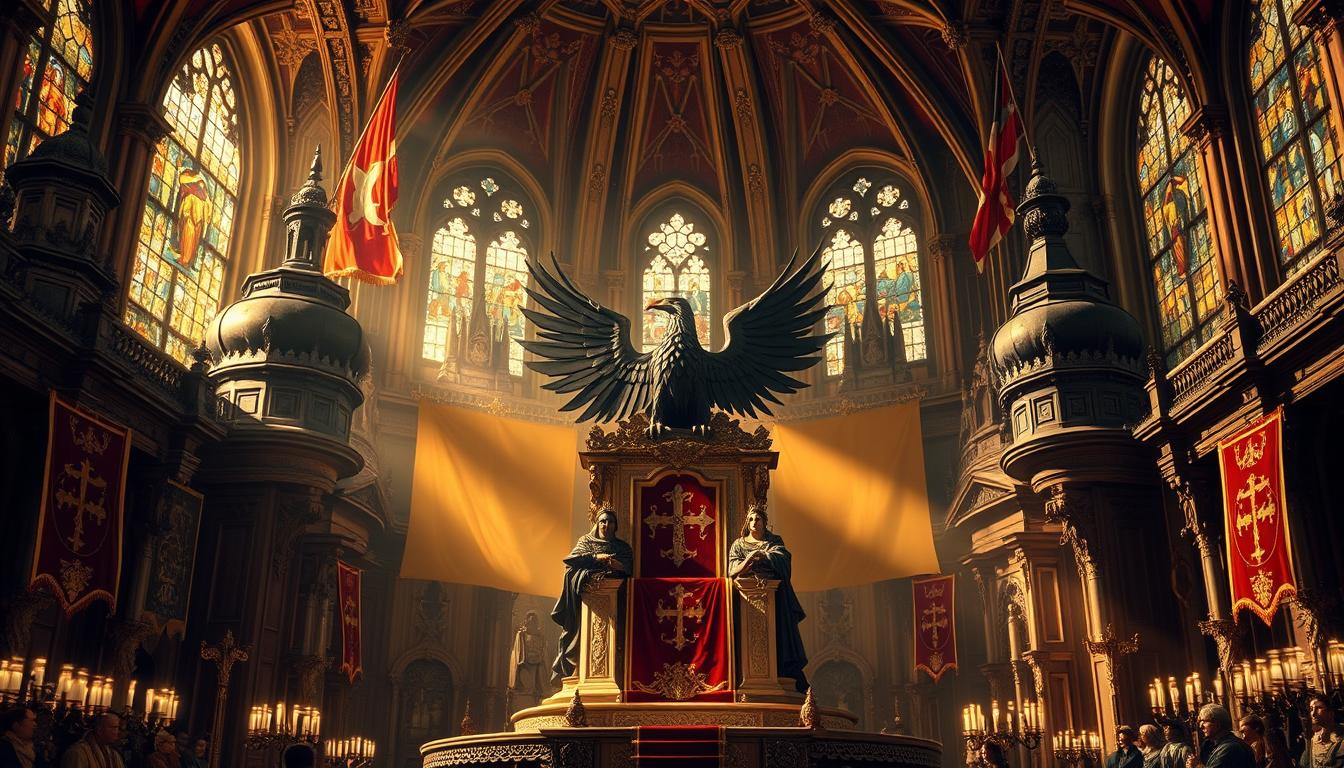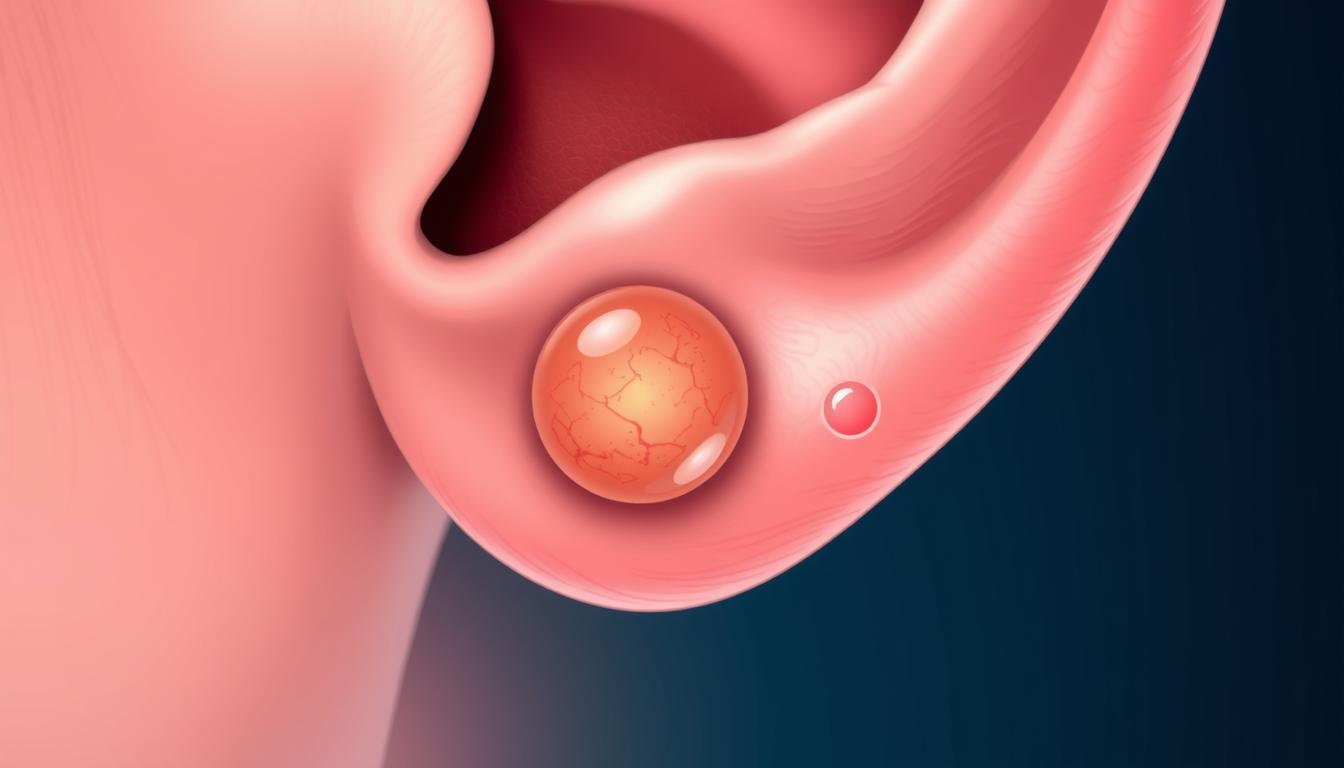The End of the Holy Roman Empire
The Holy Roman Empire was a key part of European history for almost a thousand years. Its end was a major turning point, shaping European history and leaving a lasting legacy1.
Thinking about the empire’s history, you might ask what caused its downfall. How did it influence European history, including modern borders and culture2?
Key Takeaways
- The Holy Roman Empire was a major force in European history. Its end in 1806 marked a significant era close1.
- The empire’s decline took centuries, influenced by many factors. These included the lack of a central army and treasury1.
- The Peace of Westphalia in 1648 was a key moment. It separated the empire from the papacy, leading to the rise of nation-states1.
- The empire’s legacy is seen in its impact on modern Europe. Its history continues to shape our view of European history and the end of the Holy Roman Empire2.
- Learning about the Holy Roman Empire’s history offers insights into modern European politics. It shows the evolution of the continent1.
- The empire’s story teaches us about adapting to change and effective governance. These lessons are as relevant today as they were in the empire’s time2.
Historical Context Leading Up to the End
The Holy Roman Empire’s long history helps us understand its end. It lasted over eight centuries, from Otto I’s coronation in 962 to its end in 1806. During this time, it was a key player in medieval history3.
Origins of the Holy Roman Empire
Charlemagne’s coronation in 800 by Pope Leo III started the empire’s revival. This marked the Roman Catholic Church’s growing influence in Western Europe3. Otto I then united German tribes, setting the stage for a unified Middle Ages polity4.
Key Historical Events
Several events shaped the empire’s path. The Investiture Controversy showed the struggle between church and state. The Crusades also expanded its reach beyond Europe4. The Black Death hit hard, affecting the population and economy.
Political Fragmentation
Over time, the empire broke apart politically. Power moved from the emperor to local leaders, weakening central control5. The rise of the Imperial College and the Habsburg dynasty showed the power shift in the Middle Ages4.
| Dynasty | Period | Impact |
|---|---|---|
| Ottonian | 962-1024 | Unified German tribes and established strong imperial authority5 |
| Salian | 1024-1125 | Extended the empire by adding the Kingdom of Burgundy5 |
| Staufer | 1138-1254 | Expanded imperial power but faced conflicts with the papacy4 |
| Habsburg | 1438-1806 | Hereditary emperors led to increased political fragmentation4 |
Major Factors Contributing to Its Decline
The Holy Roman Empire’s fall was caused by many factors. These included religious, political, and economic changes. These changes weakened its base.
Influence of the Reformation
The Protestant Reformation in the 16th century shook the empire’s unity. It challenged the authority of the Pope and questioned the empire’s holiness. Lutheranism and Calvinism were allowed from 1555 and 1648, but Catholicism was the only faith officially recognized.
This split made it hard for the emperor to keep control. Different beliefs caused conflicts and weakened the empire’s power6.
Rise of Nation-States
New nation-states started to break away from the empire. This change reduced the empire’s universal claims. It also made the empire’s political structure more decentralized, letting kingdoms follow their own paths.
- France became stronger under a single ruler.
- Prussia grew into a powerful military state.
- Spain and England also strengthened their national identities.
Economic Changes
Economic changes also played a big role in the empire’s decline. The fall of Constantinople in 1453 changed trade routes. This pushed European powers to find new paths, changing the economic scene7.
The rise of mercantilism gave more economic power to new nation-states. This reduced the empire’s role in trade and commerce.
| Factor | Impact |
|---|---|
| Trade Route Shifts | Decreased imperial control over commerce |
| Mercantilism | Enhanced economic power of nation-states |
| Economic Instability | Weakened overall empire’s financial foundation |
The Final Days of the Holy Roman Empire
The Holy Roman Empire, a key part of European history, faced big challenges in its last years. The Peace of Westphalia in 1648 started a trend of more freedom for its states. This weakened the power of the Holy Roman Emperor.
The Peace of Westphalia
In 1648, the Peace of Westphalia ended the Thirty Years’ War. It made it clear that each state had its own power. This meant the Holy Roman Emperor had less control8.
Role of Napoleon Bonaparte
Napoleon Bonaparte became a key player who threatened the empire. His win at the Battle of Austerlitz in December 1805 changed Europe. He then created the Confederation of the Rhine in July 1806, which went against the Holy Roman Empire9.
The Last Emperor’s Abdication
On August 6, 1806, Emperor Francis II decided to step down. This ended the Holy Roman Empire after a thousand years. Napoleon’s pressure led to this change, starting a new era in Central Europe9.
Legacy and Impact of the Empire’s End
The end of the Holy Roman Empire was a big change in European history. It shaped the future of the continent in many ways.
The changes in European borders were very noticeable.
Influence on Modern European Borders
After it ended, most of the Holy Roman Empire joined the German Confederation. The Italian states stayed separate10. This setup helped create the countries we know today in Europe.
The empire’s end also left a lasting mark on culture.
Cultural and Intellectual Contributions
The Holy Roman Empire was a hub for art, literature, and science. Latin’s influence is seen in many languages, with over 920 million people speaking it today11. It also shaped the words in English, German, and Dutch vocabularies11.
Looking at governance, the empire’s system teaches us a lot.
Reflection on Governance and Empire
The empire’s mix of unity and diversity shows the hard work of ruling a divided land. This lesson helps us today in European politics and debates on federalism and sovereignty.
The memory of the Holy Roman Empire affects European politics and identity. It reminds us of a time when different states came together under one legacy12. Knowing this history helps us understand today’s European history.
FAQ
What was the Holy Roman Empire?
Why was the Holy Roman Empire considered the legitimate successor to the ancient Roman Empire?
How did the Protestant Reformation contribute to the decline of the Holy Roman Empire?
What was the significance of the Peace of Westphalia for the Holy Roman Empire?
In what ways did Napoleon Bonaparte influence the end of the Holy Roman Empire?
What were the economic changes that affected the Holy Roman Empire’s stability?
How did the fall of Constantinople impact the Holy Roman Empire?
What is the legacy of the Holy Roman Empire in modern Europe?
Source Links
- Dissolution of the Holy Roman Empire – https://en.wikipedia.org/wiki/Dissolution_of_the_Holy_Roman_Empire
- Germany – Prussia, Napoleon, Reunification | Britannica – https://www.britannica.com/place/Germany/End-of-the-Holy-Roman-Empire
- The Holy Roman Empire | World Civilizations I (HIS101) – Biel – https://courses.lumenlearning.com/suny-fmcc-boundless-worldhistory/chapter/the-holy-roman-empire/
- No title found – https://www.oxfordreference.com/display/10.1093/acref/9780191737619.timeline.0001
- Holy Roman Empire – https://www.worldhistory.org/Holy_Roman_Empire/
- Fall of the Western Roman Empire – https://en.wikipedia.org/wiki/Fall_of_the_Western_Roman_Empire
- 1320: Section 8: The Fall of Rome: Facts and Fictions – https://www.usu.edu/markdamen/1320hist&civ/chapters/08romfal.htm
- Holy Roman Empire – https://en.wikipedia.org/wiki/Holy_Roman_Empire
- How Napoleon Ended the Holy Roman Empire – https://regencyfictionwriters.org/how-napoleon-ended-the-holy-roman-empire/
- Holy Roman Empire | Definition, History, Maps, & Significance | Britannica – https://www.britannica.com/place/Holy-Roman-Empire
- Legacy of the Roman Empire – https://en.wikipedia.org/wiki/Legacy_of_the_Roman_Empire
- The End of the Holy Roman Empire – https://www.historytoday.com/archive/end-holy-roman-empire
news via inbox
Nulla turp dis cursus. Integer liberos euismod pretium faucibua








